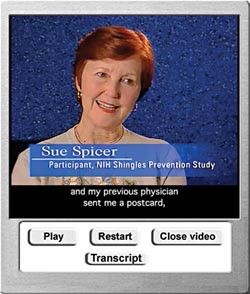
In an NIH SeniorHealth video, Sue Spicer talked about her bout with shingles, and why she took part in an NIH clinical trial that helped develop the shingles vaccine to protect others from getting it. To view it in its entirety, visit http://nihseniorhealth.gov/shingles/toc.html.
Maryland resident Sue Spicer knows firsthand about the pain and distressing symptoms of shingles. When she first showed symptoms of shingles, she and her husband happened to be taking part in an NIH-sponsored research program that later helped find a vaccine to prevent the disease. In a video interview made for the public and available on MedlinePlus.gov, Spicer tells about her bout with shingles and the antiviral drug that eased her symptoms when she developed the disease.
You can view this video and other shingles information at http://nihseniorhealth.gov/shingles/toc.html
Could you first describe your early symptoms?
The first symptom I had was pain in my right leg, and it sort of started in my upper leg and it went in both directions. It went down, and it went up. I had been very active the day before and decided, "Oh, I bet I've pulled something." So, I called my doctor, and she said, "We better look into it." The next morning I had a rash on the instep of my foot, and with the shingles study you are supposed to call them immediately if you have a rash. So, I called them and they made an appointment for me to come in to see the rash.
And when they saw the rash what did they do?
While I was there, they found another spot of rash that I did not know about on my upper buttocks. They decided they would do a scraping, and it was shingles.
How soon after the first symptoms did you get treatment?
The pain started on a Wednesday. I called them on Thursday, and I came to the NIH on Friday. The question was whether I was going to be able to drive because of the pain in my leg and whether it would be safe to do. I did drive in, and they then gave me some antiviral pills, and I was much more comfortable driving home than I was driving to the NIH office.
Did the medicine help immediately?
Immediately. I took a pill, and they waited to see if I was going to have any allergic reaction. I didn't, and then I took another pill. It was about two hours later. And then I started taking it on a regular hourly basis.
How long after you started taking the medicine did your symptoms go away completely?
A couple of days were all. I was quite amazed. By symptoms, I'm referring to pain. The rash stayed. It didn't get any worse, but it stayed and went through, I guess, a shingles cycle. It was little eruptions, and they oozed, and then they dried, and then they went away.
What would you say to someone who might think they have shingles?
Immediately consult your doctor so that you can start treating it. You need to have today's treatment, today's medicines, to take care of it immediately. It should not be something that is lingering and affects your lifestyle.
NIH-Sponsored Research Helps Find a Shingles Vaccine
The Shingles Prevention Study was a collaboration between the Department of Veterans' Affairs, the National Institute of Allergy and Infectious Diseases, and the Merck Pharmaceutical Company. This nationwide study lasted five years and vaccinated some 38,000 people 60 and older. The study led to a vaccine, named Zostavax, that is safe and effective in providing protection against shingles and associated chronic pain.
